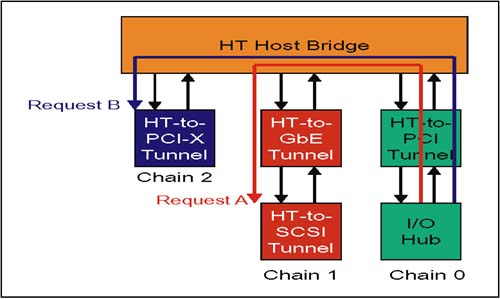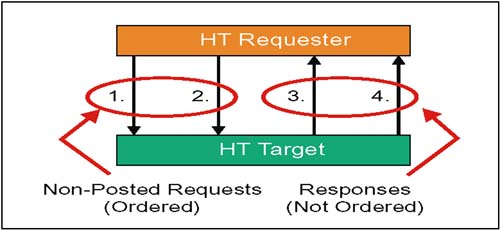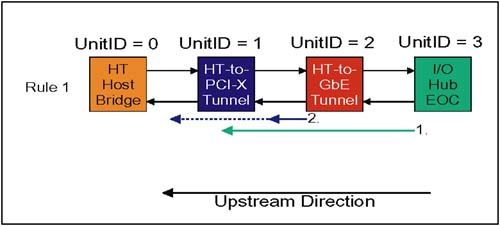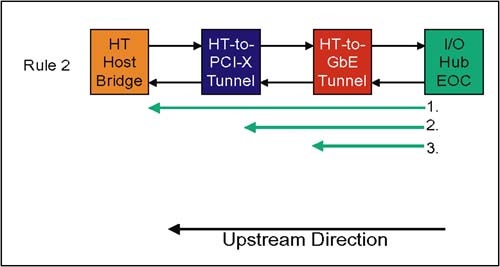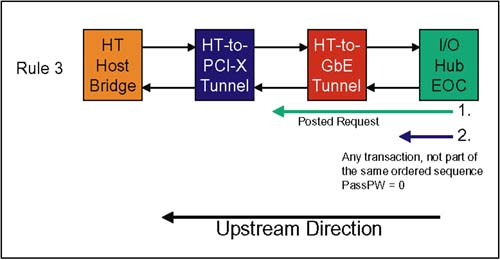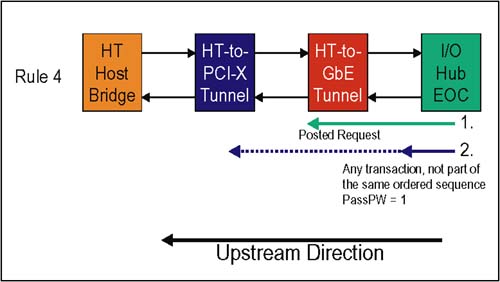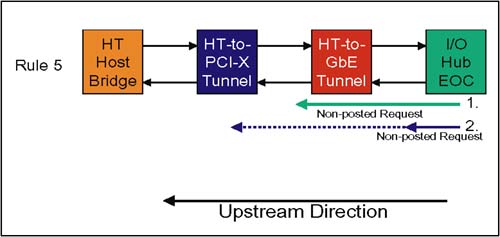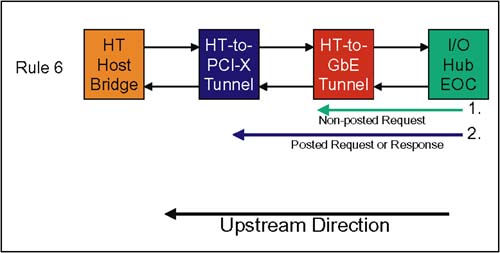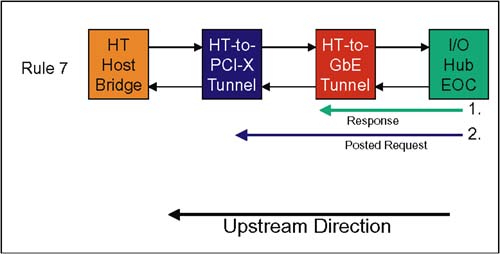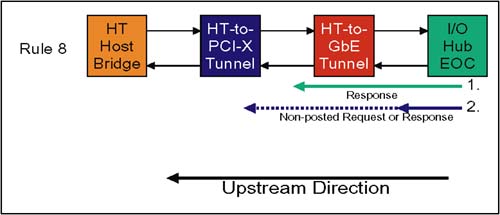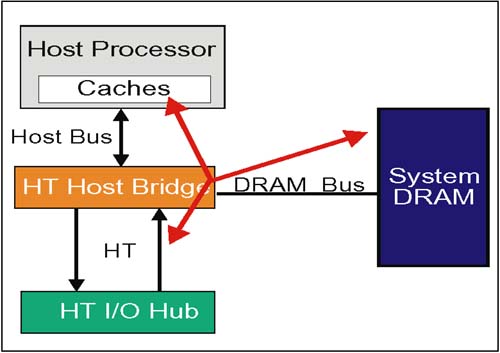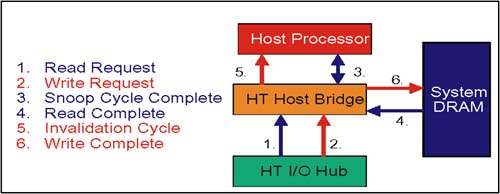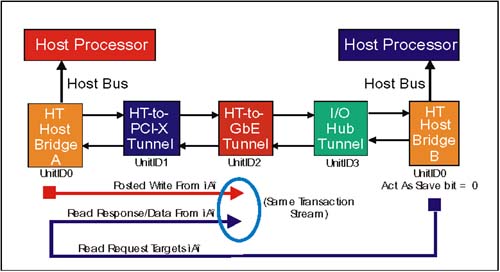The Ordering Rules
| HyperTransport packet ordering rules are divided into groups: general rules, rules for upstream I/O ordering, and rules for downstream ordering. Even the peer-to-peer example in Figure 6-1 on page 121 can be broken into two parts : the request moving to the bridge (covered by upstream ordering rules) and the reflection of the request downstream to the peer-to-peer target (covered by downstream I/O ordering rules). Refer to Chapter 20, entitled "I/O Compatibility," on page 457 for a discussion of ordering when packets move between HyperTransport and another protocol (PCI, PCI-X, or AGP). General I/O Ordering LimitsOrdering Covers Targets At Same Hierarchy LevelOrdering rules only apply to the order in which operations are detected by targets at the same level in the HyperTransport fabric hierarchy. Referring to Figure 6-2 on page 122, assume that two peer-to-peer writes targeting devices on two different chains have been performed by the end device in chain 0. Figure 6-2. Targets At Different Levels In Hierarchy And In Different Chains In the illustration Figure 6-2 on page 122, assume that Request A, a write transaction, is sent first. This is immediately followed by Request B, another write request. HyperTransport general ordering rules are then applied:
Read And Non-Posted Write Completion At TargetNon-posted transactions issued by one requester to the same target are required to complete at the target in the order they were issued by the requester. This means that any combination of reads and non-posted writes must complete at the target in the original order they were issued. However, there is no ordering guarantee on the responses which are returned for each. Referring to Figure 6-3 on page 123, ordering rules for target completion of non-posted requests and subsequent responses may be summarized:
Figure 6-3. Non-Posted Requests And Responses At Target Ordering rules require that the two requests be handled internally by the target in order. When the responses return, they may come back in either order (3) and (4). The results of non-posted transactions must be globally visible (to all system devices) before a response is returned. What If A Device Requires Response Ordering?All HyperTransport devices must be able to tolerate out-of-order response delivery or else restrict outstanding non-posted requests to one at a time. This also applies to bridges which sit between HyperTransport and a protocol that requires responses be returned in order. The bridge must not issue more outstanding requests than it has internal buffer space to hold responses it may be required to reorder. Support For The Producer-Consumer Ordering ModelWhen the PassPW and Sequence ID bits are cleared in a request packet, HyperTransport transactions are compatible with the same producer-consumer model PCI employs. Basic features of the model include:
Producer-Consumer Model Simpler If Flag/Data In Same PlaceIf the flag and data are restricted to being in the same device, the PassPW bit may be set in requests which relaxes the ordering of responses and improves performance. At the same time, the producer-consumer model is maintained . Upstream Ordering RulesPosted requests, non-posted requests, and responses travel in independent virtual channels. Each uses a different command, which permits devices to distinguish them from one another. Requests have a Sequence ID field. Assigning non-zero sequence ID fields to non-posted requests forces all tunnel and bridge devices in the path to the target to forward these requests in the same order they were received. The target is also required to maintain this order when processing these requests internally. Requests with a Sequence ID of zero are not considered to be part of an ordered sequence. Requests and response packets also carry a May Pass Posted Writes (PassPW) bit. Reordering Packets In DifferentTransaction StreamsOther than when a Fence command is issued, there is no ordering guarantee for packets originating from different sources. Traffic from each UnitID is considered a separate transaction stream; devices may reorder upstream packets from different streams as necessary. Figure 6-4 on page 125 depicts reordering being done by a tunnel (UnitID1); this device is forwarding packets upstream on behalf of two devices behind it (UnitID2 and UnitID3).
Figure 6-4. Upstream Reordering: Packets From Different Transaction Streams No Reordering Packets In AStrongly Ordered SequenceIf one requester has issued a series of request packets carrying the same non-zero SequenceID, the packets may not be reordered (regardless of the state of the PassPW bit. The sequence only applies to packets within a single transaction stream (UnitID) and VC. Upstream devices still may reorder these packets with respect to those from other streams. Figure 6-5 on page 126 illustrates an ordered sequence issued by an I/O Hub cave device. Key details include:
Figure 6-5. A Strongly Ordered Sequence Must Be Preserved Packets With PassPW Bit Clear Are Restricted In PassingPackets with the PassPW bit clear must not pass an already posted request in the same stream and not part of the same ordered sequence. This forces packets of all types (posted request, non-posted request, or response) which have not been granted relaxed ordering privileges to remain behind all previously posted requests within the same transaction stream. This guarantees the ultimate target (e.g. host bridge) will see them all in the original order they were issued. Figure 6-6 on page 127 illustrates this case.
Figure 6-6. Packets With PassPW Clear Can't Pass Posted Requests Packets With PassPW Bit Set May Or May Not PassPackets with the PassPW bit set may or may not pass an already posted request in the same stream and not part of the same ordered sequence. It is up to the forwarding devices to determine whether there is a benefit to reordering the two. Figure 6-7 on page 128 illustrates this case.
Figure 6-7. Packets With PassPW Set May Or May Not Pass Other Posted Requests Non-Posted Requests May Pass Each OtherFor non-posted requests which are not part of an ordered sequence (Sequence ID = 0), ordering rules allow them to pass other non-posted requests in the same transaction stream. Again, it is up to the forwarding devices to determine whether there is a benefit to reordering the non-posted requests. Figure 6-8 on page 129 illustrates this case.
Figure 6-8. Non-Posted Requests May Pass Each Other Posted Requests And Responses Must Be Able To PassPosted requests and responses must be able to pass previous non-posted requests that are not part of the same ordered sequence. This is part of the HyperTransport deadlock- avoidance strategy. Note: The HyperTransport specification provides several additional recommendations for designers related to deadlock-avoidance. Figure 6-9 on page 130 illustrates the case of posted requests and responses passing previous non-posted requests in the same virtual channel.
Figure 6-9. Posted Request Or Response Must Be Able To Pass Non-Posted Requests Posted Request Must Be Able To Pass A ResponsePosted requests must be able to pass an earlier response which is not part of the same ordered sequence. This is another component of the HyperTransport deadlock-avoidance strategy. Note: The HyperTransport specification provides several additional recommendations for designers related to deadlock-avoidance. Figure 6-10 on page 131 illustrates the case of a posted requests passing an earlier response packet in the same transaction stream
Figure 6-10. Posted Request Must Be Able To Pass An Earlier Response Non-Posted Requests Or Response May Pass A ResponseNon-Posted requests or responses may or may not pass an earlier response which is not part of the same ordered sequence. Figure 6-11 on page 132 illustrates the case of a non-posted request or response passing an earlier response packet in the same transaction stream
Figure 6-11. Non-Posted Request/Response May Pass Earlier Responses Host Ordering RequirementsA system that hosts HyperTransport must assure that the ordering of virtual channel traffic in the HyperTransport topology is extended to the host system. Because the host bridge interfaces directly to the processor(s), main memory, and the HyperTransport fabric, it plays a central role in enforcing the proper ordering interaction between the host system and HyperTransport. Figure 6-12 on page 133 illustrates the central role played by the host bridge in host system and HyperTransport ordering. Figure 6-12. Host Bridge Extends Ordering To Host System Note that some aspects of host system ordering are system-specific. For example, CPU host bus protocol and cache management vary with the processor. Still, host ordering rules make it possible for any host system to reliably interact with the HyperTransport fabric. Host Ordering Requirements: General FeaturesThe HyperTransport specification breaks down the ordering rules governing transaction completion in the host system into a set of rules for ordered pairs of transactions. Depending on the request types and where the target locations are, the second request may be received but might have to wait to take effect in the host fabric until the first request reaches a specific point in completion called its ordering point. "Taking effect", in this case, means that a read request actually fetches data, a write request actually exposes new data, peer-to-peer requests are actually queued for reissue downstream, etc. How read and write accesses originating in HyperTransport are handled depends on the type of space they target in the host system.
Two Ordering Points Are DefinedThere are two ordering points (degrees of transaction completion) defined for the first transaction in an ordered pair; this information is used in determining whether the second request of the ordered pair may take effect or must wait. The ordering points are called Globally Ordered (GO) and Globally Visible (GV). Globally Ordered (GO)HyperTransport defines the globally ordered point for the first request as the point where it is guaranteed to be observed in the correct order (with respect to the second transaction) from any "observer". While the two transactions are guaranteed to complete in the proper order, they may not have actually done so yet. This means agents such as caches may not have been updated at this ordering point. Globally Visible (GV)HyperTransport defines the globally visible ordering point for the first request as the point where it is assured to be "visible" to all observers (CPUs, I/O devices, etc.). It also means that all side effects of the first request (cache transitions, etc.) have completed. Note: If there are no "sideband" agents (caches, etc.), GO and GV are equivalent. Ordering Rule SummaryTable 6-1 on page 134 summarizes the host ordering rules for various combinations of transaction ordered pairs. Table 6-1. Summary Of Host Ordering Rules For Transaction Pairs
Host Responses To Non-Posted RequestsAlthough the second request in an ordered pair may be allowed to take effect in the host system before the first request is globally visible, the host is not allowed to return the response for a non-posted HyperTransport request until all previous ordered requests are complete and the side effects (e.g. cache state transitions) of the current request are similarly globally visible. An Example (Refer to Table 6-1 and Figure 6-13)Figure 6-13. Ordering Example: Read Followed By Posted Write To Cacheable Memory Assume that an ordered pair of requests have been received by the host bridge. The first is a read request targeting a cacheable area of memory; the second is a non-posted write targeting the same location in cacheable memory space. Both requests are part of the same strongly ordered sequence (same stream, same VC, SeqID >0). According to Table 6-1 (see line number 3), the second request (cacheable write) must wait until the first request is globally ordered (it is guaranteed to complete first).
Downstream I/O OrderingDownstream ordering rules in HyperTransport are much the same as the upstream rules previously described, with a few exceptions:
Double-Hosted Chain OrderingUpstream traffic and downstream traffic in HyperTransport have no ordering interaction because they are in different transaction streams. A special case arises in sharing double-hosted chains when one of the host bridges must send traffic to the other host bridge. Refer to Figure 6-14 on page 138.
Figure 6-14. Double-Hosted Chain Ordering |
EAN: 2147483647
Pages: 182
